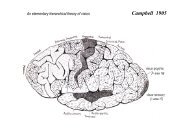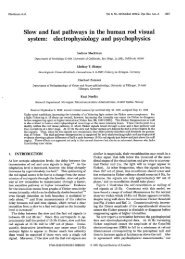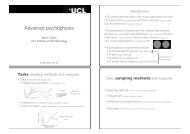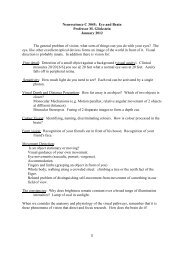Long-wavelength adaptation reveals slow ... - Journal of Vision
Long-wavelength adaptation reveals slow ... - Journal of Vision
Long-wavelength adaptation reveals slow ... - Journal of Vision
Create successful ePaper yourself
Turn your PDF publications into a flip-book with our unique Google optimized e-Paper software.
<strong>Journal</strong> <strong>of</strong> <strong>Vision</strong> (2005) 5, 702–716 Stockman & Plummer 713background in the sense that the M- and L-cone signals itgenerates are balanced postreceptorally. On such a background,we assume that the <strong>slow</strong> signals are minimized bydestructive interference (see Stockman & Plummer, 2005).Suppression <strong>of</strong> the fast M-cone signal(+fM) by long-<strong>wavelength</strong> fieldsWe assume that the weights <strong>of</strong> the +sM versus sL and+sL versus sM inputs are balanced so that no <strong>slow</strong>signal is found under equichromatic conditions, when thetarget and background are <strong>of</strong> the same <strong>wavelength</strong>. To theextent that this assumption is true, the differences betweenm for the M- and for the L-cones (see Table 1) musttherefore reflect differences between the amplitudes <strong>of</strong> thetwo fast signals (i.e., +fL 9 +fM, by the ratio <strong>of</strong> m for theM-cones divided by m for the L-cones). A stronger +fLthan +fM cone signal is expected in most subjects, simplybecause the L-cone contribution to luminance is usuallylarger than the M-cone contribution (e.g., De Vries, 1948a;Smith & Pokorny, 1975; Stromeyer et al., 1985; Vos&Walraven, 1971; Walraven, 1974; Sharpe et al., in press),an asymmetry that is also found for our subjects, ASand DP. The asymmetries that we find, however, are toolarge to be due solely to different L- and M-cone contributionsto luminance. We must suppose, therefore, thatthe intense long-<strong>wavelength</strong> field causes an additionaland selective suppression <strong>of</strong> the +fM signal (or M-cone luminanceinput).Another aspect <strong>of</strong> our data is also consistent withan additional suppression <strong>of</strong> the +fM signal by the long<strong>wavelength</strong>field. At Level 4, the flicker spectral sensitivityat 22.5 Hz is as close to the L-cone spectral sensitivityas it is at 15 Hz (see also Figure 3 <strong>of</strong> Stockman et al.,2005). Given that the <strong>slow</strong> M-cone signals (+sM) and fastM- and L-cone signals (+fM and +fL) are only about 90-(DP) or 120- (AS) apart at 22.5 Hz (according to themodel fits), the shift to an L-cone spectral sensitivity atthis frequency cannot be entirely due to destructiveinterference. Such a shift towards L is also consistentwith a selective suppression <strong>of</strong> the +fM signals underconditions <strong>of</strong> long-<strong>wavelength</strong> <strong>adaptation</strong>, as are the veryhigh <strong>slow</strong>/fast signal ratio (m) values for the M-cones butnot for L-cones (see Table 1). This suppression seems tobe confined to the fast M-cone signals because thespectral sensitivities at 2.5 Hz and 7.5 Hz are not similarlyshifted towards L even at the highest backgroundradiance.Our evidence for a relative suppression <strong>of</strong> the +fMsignal on deep-red fields might seem at odds with the conclusions<strong>of</strong> others, based on 15- and 22.5-Hz flicker spectralsensitivity data, that it is the +fL signal (or L-coneluminance input) that is suppressed (Eisner & MacLeod,1981; Stromeyer et al., 1997; Stromeyer et al., 1987). However,our evidence and model suggest that any Bsuppression[<strong>of</strong> L is restricted to moderate long-<strong>wavelength</strong>intensities (being largest near 11.21 log 10 quanta s 1 deg 2 )and is due to a large extent to destructive interference betweenthe <strong>slow</strong> and fast cone signals rather than to suppression.The suppression that we find under conditions <strong>of</strong>long-<strong>wavelength</strong> <strong>adaptation</strong> is mainly a suppression <strong>of</strong>the +fM signals (see the m values in Table 1).Stiles k mechanismsThe changes in the slopes <strong>of</strong> the FTVR curves shownin Figure 5 are reminiscent <strong>of</strong> the changes in the slopes<strong>of</strong> threshold-versus-radiance (TVR) curves identifiedby Stiles as a transition from k 4 to k 4 or from k 5 to k 5(Stiles, 1953). The transitions between low (k 4 ) and high(k 4) intensity forms <strong>of</strong> predominantly M-cone mechanisms,or between low (k 5 ) and high (k 5) intensity forms <strong>of</strong> predominantlyL-cone mechanisms, were the subject <strong>of</strong> someexperimental interest in the early 1980s (e.g., Kirk, 1985;Reeves, 1982; Sigel & Brousseau, 1982; Sigel & Pugh,1980; Wandell & Pugh, 1980). We suggest that the transitionfrom k 4 to k 4 found on deep-red 667-nm fieldsreflects the same underlying change from sM+sL to+sM sL that we report here.ConclusionsUnder long-<strong>wavelength</strong> <strong>adaptation</strong>, fast nonopponentsignals (+fM+fL) and <strong>slow</strong> spectrally opponent signals(+sM sL and sM+sL) contribute to achromatic luminanceflicker perception. These signals constructively anddestructively interfere to produce characteristic, frequencydependentchanges in spectral sensitivity and phase delaydata without producing visible color variation. The twospectrally opponent signals seem to coexist at some levels,but their relative contributions to luminance change from apredominance <strong>of</strong> sM+sL at low long-<strong>wavelength</strong> <strong>adaptation</strong>levels to a predominance <strong>of</strong> +sM sL at high levels.AcknowledgmentsWe thank Rhea Eskew, Ted Sharpe, and HannahSmithson for helpful comments. This work was previouslysupported by NIH grant EY10206 and is currently supportedby a Wellcome Trust grant, both awarded to AS.Commercial relationships: none.Corresponding author: Andrew Stockman.Email: a.stockman@ucl.ac.uk.Address: Institute <strong>of</strong> Ophthalmology, University CollegeLondon, 11Y43 Bath Street, London EC1V 9EL, UK.










